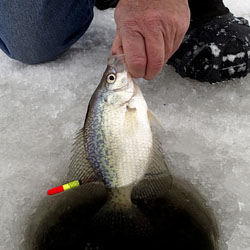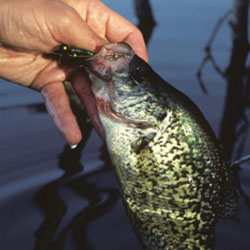Many crappie fishermen hang up their rods during the cold winter months, winterize their boats and sit back patiently waiting for spring. On the other hand, a lot of successful fishermen continue to fish for crappie all winter long, and for good reason: finding crappie in the winter can be easier than it is in the spring and summer.
To find winter crappie, look for submerged creek and river channels in 15 to 40 feet of water. What you're looking for is brush or submerged trees along these channels. Crappie will be holding somewhere in or around that cover. Crappie, like bass and most other species, almost always stage close to some type of cover, and they seem to prefer brush-piles or submerged trees as their cover of choice. Underwater ledges next to deeper channels may also be holding a few crappie, if there is some type of cover nearby. If a warm front comes through and the temperatures rise for a few days, crappie may begin to move up to flats along the creek channels.
Now that I've found the crappie, I'm ready to fish. But what bait do I use? Small, lightweight jigs is the answer. Remember that in the cold water, the crappie are moving slower, and they aren't going to chase a lure very far. So use light jigs and fish them slow. Use a 1/8 or lighter jig on a lightweight or medium-light rod, and if you noted any fish on your depth finder, drop the jig just over them and be ready for a strike. Move the jig slowly up and down, or use very light twitches. You won't get the aggressive strikes like you do in the spring and summer, often you will only feel a slight tug or even just a little pressure. This is where the light tackle comes in. Light-weight rods and 4 to 6 pound test line will enable you to feel these subtle strikes. If you know the crappie are there, and your jigs are just not working, try adding a crappie nibble or if you can, tip it with a small minnow. That will sometimes entice a strike from finicky fish.
Marabou and feather-type jigs can be very effective for winter crappie, as well as "umbrella" type jigs. The slower rate-of-fall seems to be the trick with these. Whatever type of jig you choose, just remember to fish it very slow.
On a clear, sunny day use light colored jigs, and on cloudy days you can go with a darker color, but I prefer a white, yellow, light green or chartreuse color. The same rule applies to water clarity, in clear water use very light colors or even clear with some sparkle. In stained water, use a darker green or chartreuse. There are so many different color variations nowadays it can be overwhelming trying to pick the "perfect" color. with colors like "bayou booger", "firecracker", "woodpecker" and "electric chicken", everyone today seems to have a different favorite. The way I do it is try a few different color combinations at first, fishing with 3 or 4 separate rods, and when I seem to be catching more crappie on a particular color, stick with that color.
When ice fishing for crappie, fish over the deeper brush piles you found in the spring, summer or fall. The crappie will be holding tight to this cover, Their lower metabolism in the cold water means they won't venture far from it when foraging for food. This also means that they will often readily inhale a jig when they see it, not passing up an opportunity for a morsel of nutrition. The trick here is, if you catch a few crappie and then the bite stops, move and drill another hole over another brush pile.
In the dead of winter, in February for example, you may find that the crappie have moved to even deeper water, and are staged along the edges of the deeper channels. In these locations, they will usually suspend just a foot or two off of the bottom. When they are this deep, I have had great success using a bottom rig. Tie on a barrel swivel at the end of your line. Then tie on a 3 foot section of line with a bass casting sinker or a cannonball sinker on the other end of the swivel. Usually a 3/4 ounce sinker will do, but if there's more current you'll have to use a heavier one. Then tie on a 1 or 2 foot section of line on the swivel with a hook and minnow at the end, or a jig tipped with a minnow or crappie nibble. Drop this straight down, and when it hits bottom, reel up just a smidgen. I have caught well over 50 crappie in one spot using this method, in just a couple of hours.
If you are using any of these methods and are catching a lot of crappie, but all of them are small and not keeper size, go to a bigger jig. Sometimes the larger fish will only strike at larger baits, letting the little guys eat up the small stuff. If I'm catching nothing but little ones, I'll switch to 2 inch jigs. Often that will get the "bigguns" to react.
I hope that by using these winter crappie tips you can go out and catch yourself a nice "mess" of crappie, just remember to adhere to the game and fish laws, slot limits, daily limits, etc. Another thing to remember is to bring adequate clothing for the temperature, keeping the wind chill factor in mind. You don't want to be miserable while out on the water, and you can always take off a layer of clothing if you get too warm. Check the weather forecast before you go, pay attention to the wind speed, and dress accordingly.
|










